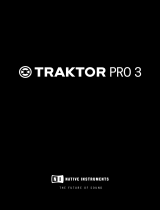
4 - MIXING TRACKS
Mixing tracks means to link up songs,
one after another, without any gaps or
silences between them.
4.1 You have loaded a track on each deck
(A and B). Position the volume faders as
shown below.
4.2 You start o by playing the track on
deck A.
4.5 Before the end of the track being
played, start playing the track loaded on
deck B.
4.3 Set the crossfader to the side of the
deck on which the track is playing (here,
to the left).
4.4 Select previewing on deck B (please
see 3. Previewing a track).
4.6 To ensure a transition at the same
tempo, synchronize the BPM (number of
beats per minute) of the track that you are
getting ready to play. Here, press the Sync
button on deck B (1) to make the BPM of
this track match the BPM of the track that
will be nishing (on deck A). Or you can
adjust the BPM to match the BPM of the
track on deck A using the pitch stick (2).
4.7 To make the transition, progressively
move the crossfader toward the deck on
which the new track is being played (here,
to the right).
A
B
A
B
B
B
1
2
A B


















